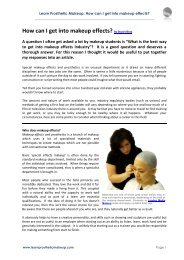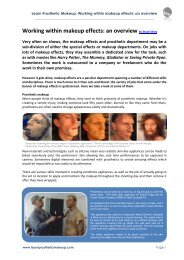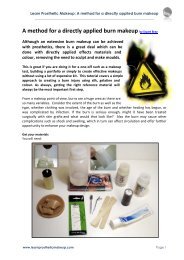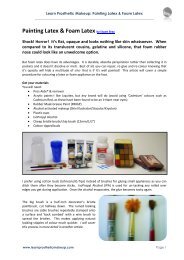A basic makeup effects kit by Stuart Bray - Learn Prosthetic Makeup
A basic makeup effects kit by Stuart Bray - Learn Prosthetic Makeup
A basic makeup effects kit by Stuart Bray - Learn Prosthetic Makeup
You also want an ePaper? Increase the reach of your titles
YUMPU automatically turns print PDFs into web optimized ePapers that Google loves.
<strong>Learn</strong> <strong>Prosthetic</strong> <strong>Makeup</strong>: A <strong>basic</strong> <strong>makeup</strong> <strong>effects</strong> <strong>kit</strong><br />
________________________________________________________________<br />
Brushes<br />
Brushes are important,<br />
but they need not be<br />
expensive. Art and craft<br />
supply stores sell sets of<br />
brushes made with sable<br />
and synthetic fibres.<br />
Get a variety of sizes-<br />
some small (size 2 to 4),<br />
medium (6 to 8) and large<br />
(12 to 14). Sable brushes<br />
can cost a lot, and frankly<br />
are not necessary in this<br />
kind of work. Nylon or acrylic fibres will work just as well. I also use large laminating or chip brushes,<br />
cut down with scissors to create a spatter brush for flicking colours from hardware stores-<strong>basic</strong>ally<br />
cheap bristle paintbrushes. One or two larger brushes can be flared out to create much more realistic<br />
application of colour.<br />
Sponges<br />
Colour application in <strong>effects</strong> is usually all about breaking colour up, and avoiding flat, single colours. A<br />
big car washing sponge can be torn or cut up into many pieces. This is great for applying initial basecolours,<br />
as well materials such as latex.<br />
A couple of red-rubber and black stipple-sponges are great too. These<br />
are good for applying colour break-up in a much more convincing way<br />
than plain sponge.<br />
Three Dimensional Materials<br />
Directly applied materials used to create a three dimensional form are great for one-off <strong>effects</strong> such as<br />
portfolio pieces or test <strong>makeup</strong>s.<br />
� Waxes such as ‘morticians’, ‘nose and ‘scar’ wax are quick to apply and colour. They are not<br />
very durable, however, and can be easily damaged <strong>by</strong> touch.<br />
� Latex can be built up in layers <strong>by</strong> itself or with tissue paper or cotton wool to create skin peeling<br />
<strong>effects</strong>. Latex is very flexible and durable. Avoid using crème <strong>makeup</strong>, as it often looks patchy<br />
on latex. Also, check for latex allergies before you start using it on a subject’s skin. Eyelash<br />
adhesive is often made from latex.<br />
� Gelatine and gelatine based products (such as Gelefects) are quick ways of building up very<br />
realistic skin, especially burns. You can make your own or buy pre made blocks. Gelatine is used<br />
as a liquid and requires heating to get it to this state. Molten gelatine can burn skin. Always be<br />
careful to avoid injury and check the temperature before applying it to skin!<br />
� Silicone based modelling materials such as SculptGel and Third Degree are easy to use, flexible<br />
and durable. They usually come as a two-part material mixed in equal quantities and applied<br />
directly to skin. Unlike wax, they are not easily damaged <strong>by</strong> touch and hypoallergenic. It may<br />
have a third component added to soften the mixture.<br />
www.learnprosthetic<strong>makeup</strong>.com Page 2









